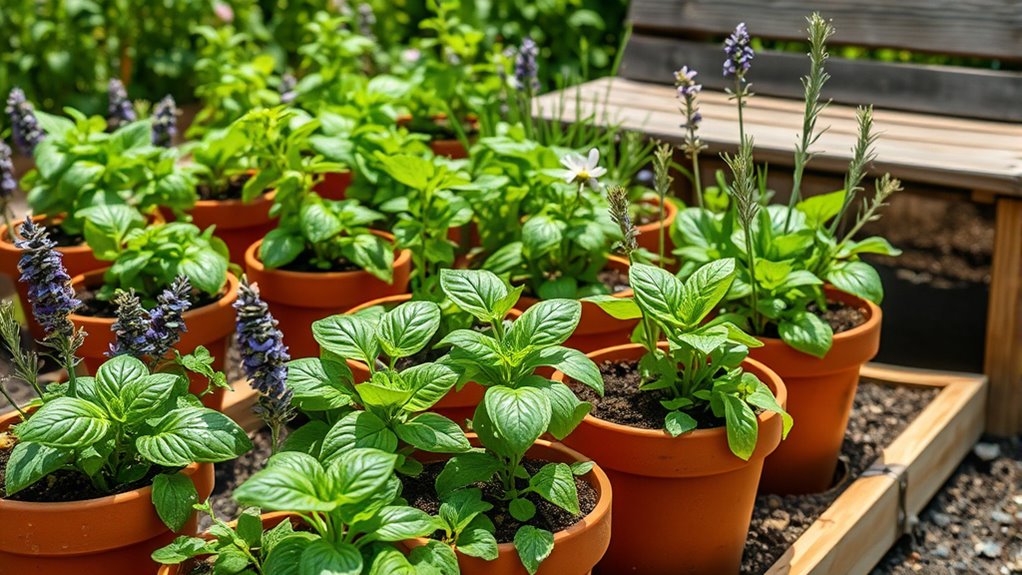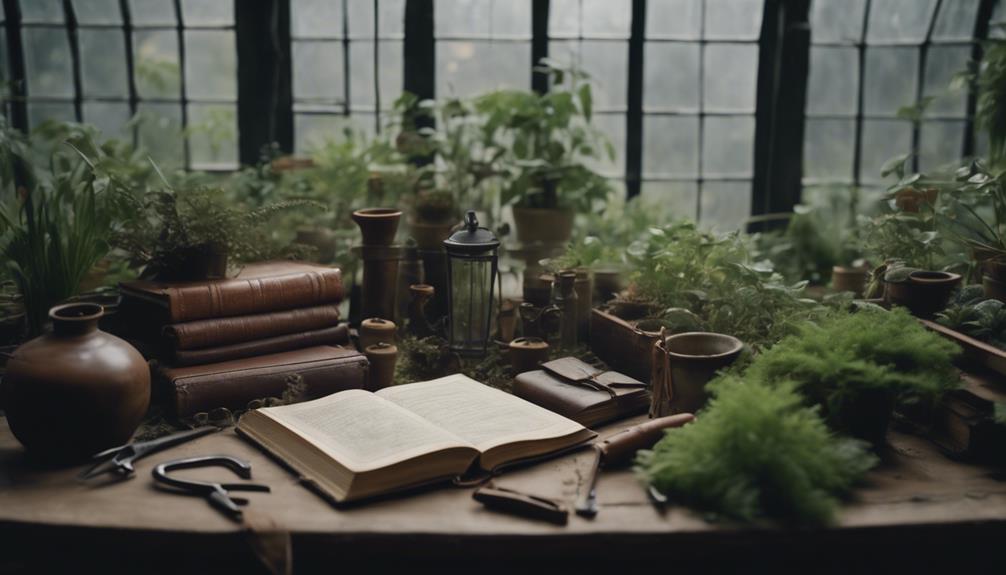Start your medicinal herb garden with hardy, easy-to-grow plants like chamomile, lavender, peppermint, and Echinacea. Choose herbs suited to your climate and soil, and select healthy, pest-free specimens. Harvest at peak potency before flowering and use sharp tools for clean cuts. Prepare your soil with organic matter, ensuring good drainage and sun exposure. For more tips on nurturing your herbs and keeping your garden healthy, keep exploring these helpful strategies.
Key Takeaways
- Choose hardy, easy-to-grow herbs like chamomile, lavender, peppermint, and Echinacea suited to your climate.
- Prepare well-draining, nutrient-rich soil with organic amendments in a sunny location.
- Harvest herbs at peak potency, just before flowering, using clean tools and avoiding overharvesting.
- Regularly prune and pinch back herbs like mint and basil to encourage bushiness and healthy growth.
- Monitor soil moisture and plant health to maintain vigorous, productive medicinal herb plants.

Creating your own medicinal herb garden is a rewarding way to have natural remedies at your fingertips. When starting out, selecting the right starter plants makes all the difference. Herbs like chamomile, lavender, peppermint, and Echinacea are excellent choices for beginners because they’re hardy and versatile. Once you’ve picked your herbs, the next vital step is herb harvesting and soil preparation. Proper herb harvesting ensures you get the most potent and healthy parts of your plants, while soil preparation sets the foundation for vigorous growth.
Before planting, you need to prepare your soil carefully. Start by choosing a sunny spot—most medicinal herbs thrive in full sun, receiving at least six hours of direct sunlight daily. Clear the area of weeds, grass, or debris, as these can compete with your herbs for nutrients and water. Loosen the soil using a garden fork or tiller, breaking it up to improve aeration and drainage. Incorporate organic matter such as compost or aged manure to enrich the soil with nutrients, which encourages healthy root development. A well-prepared soil will hold moisture without becoming waterlogged, preventing root rot and promoting strong, vigorous plants. Additionally, understanding the importance of soil quality can help ensure your herbs grow optimally.
When it comes to herb harvesting, timing is key. You want to harvest herbs when they’re at their peak potency—usually just before they flower, as this is when their essential oils are most concentrated. Use clean, sharp scissors or pruning shears to cut the herbs, making sure not to remove more than one-third of the plant at a time. This allows the plant to recover and continue producing throughout the season. For herbs like mint and basil, you’ll want to regularly pinch back new growth to encourage bushier, more productive plants. For woody herbs like lavender, harvest the stems in the morning after dew has dried but before the heat of midday, which helps preserve their aroma and essential oil content.
Frequently Asked Questions
Which Medicinal Herbs Are Best for Beginners?
If you’re new to herb planting, start with easy medicinal herbs like basil, mint, chamomile, and thyme. These are beginner-friendly, thrive with minimal care, and provide useful remedies. To succeed, follow beginner tips like choosing the right location, watering consistently, and using quality soil. These herbs are resilient, quick to grow, and perfect for building your confidence in cultivating medicinal plants at home.
How Often Should I Harvest Medicinal Herbs?
Perfectly planning your plant’s progress, you ask about harvest timing. You should harvest medicinal herbs when they reach plant maturity, which varies by herb but often occurs just before flowering. Regularly check your herbs, and harvest at the right moment to maximize potency and flavor. Don’t wait too long; early harvesting preserves essential oils and medicinal qualities. Keep an eye on your plants’ growth, and you’ll harvest healthy, hearty herbs whenever they’re at their best.
Can Medicinal Herbs Be Grown Indoors Year-Round?
Yes, you can grow medicinal herbs indoors year-round. Choose suitable herb container options like pots with drainage to keep roots healthy. Use indoor lighting tips such as placing plants near south-facing windows or supplementing with grow lights to guarantee they get enough light. Regular watering and proper airflow are also key. With attention to these factors, your medicinal herbs will thrive indoors regardless of the season.
Are There Any Safety Concerns With Homemade Herbal Remedies?
Did you know that up to 20% of herbal remedies can cause adverse reactions? When making homemade remedies, herbal safety is vital. Always research proper dosages and avoid toxic plants. Follow homemade remedy precautions like using clean tools and consulting professionals if unsure. This way, you minimize risks and enjoy the benefits of your herbal creations safely. Always prioritize safety to guarantee your herbal healing journey is both effective and secure.
How Do I Prevent Pests From Damaging My Herb Garden?
To prevent pests from damaging your herb garden, you should practice organic pest control methods and use companion planting. Plant pest-repellent herbs like basil or marigolds alongside your main herbs to deter unwanted insects. Keep your garden healthy by regularly inspecting plants and removing pests manually. Additionally, maintaining proper spacing and good airflow helps reduce pest problems naturally, ensuring your herbs stay vibrant and pest-free.
Conclusion
Now that you know how to start your medicinal herb garden, there’s no limit to what you can achieve. With a little care, your garden will flourish more than you ever imagined—it’s like holding a pharmacy in your backyard. Keep experimenting and learning, and soon you’ll have a sanctuary of healing herbs at your fingertips, transforming your wellness routine into something truly extraordinary. Your green thumb has the power to change your life—so go ahead, grow something amazing!










